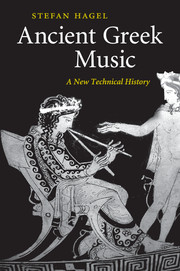Book contents
- Frontmatter
- Contents
- List of diagrams
- List of tables
- List of figures
- List of abbreviations
- Preface
- 1 The evolution of ancient Greek musical notation
- 2 Notation, instruments and the voice
- 3 Notation in the handbooks
- 4 Strings and notes
- 5 Fine tuning
- 6 Going beyond Ptolemy?
- 7 Assisted resonance
- 8 The extant musical documents
- 9 Aulos types and pitches
- 10 Before Aristoxenus
- 11 Synthesis
- Bibliography
- Indices
1 - The evolution of ancient Greek musical notation
Published online by Cambridge University Press: 03 May 2010
- Frontmatter
- Contents
- List of diagrams
- List of tables
- List of figures
- List of abbreviations
- Preface
- 1 The evolution of ancient Greek musical notation
- 2 Notation, instruments and the voice
- 3 Notation in the handbooks
- 4 Strings and notes
- 5 Fine tuning
- 6 Going beyond Ptolemy?
- 7 Assisted resonance
- 8 The extant musical documents
- 9 Aulos types and pitches
- 10 Before Aristoxenus
- 11 Synthesis
- Bibliography
- Indices
Summary
By the middle of the third century BC, from which the first preserved documents of ancient Greek written music date, musical notation was already firmly established; it had acquired much of the inner structure that emerges from the full account given in Alypius' handbook, compiled perhaps half a millennium later. Thus we are not in a position to directly observe the evolution of this system out of more primitive precursors; its origins are the object of speculation. Although some work has been done on this subject, there are several details for which no adequate explanation has been proposed so far. In the following chapter a new theory of the original conception and early evolution of ancient notation will be derived mainly from internal structural evidence. In accord with the nature of such an approach, this initial argument evolves on rather abstract lines. This might seem hardly appropriate for a musical subject, but it allows the development of a consistent view from a very limited body of evidence. It will be left to the later chapters to embed the conclusions, sometimes with modifications, into a broader, more practical and historical, picture.
THE NOTATION
Greek notation was based on letters or letter–like signs, each one designating a certain functional position within a network of musical scales.
- Type
- Chapter
- Information
- Ancient Greek MusicA New Technical History, pp. 1 - 52Publisher: Cambridge University PressPrint publication year: 2009



